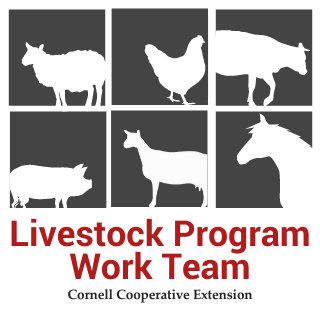Prevention of Highly Pathogenic Avian Influenza (HPAI) in Ratities
By Amy Barkley, Livestock & Beginning Farm Specialist, Cornell Cooperative Extension
Background:
Avian Influenza is a highly contagious poultry virus that has the potential to cause large financial losses to the U.S. poultry industry. A highly pathogenic strain (HPAI), H5N1, last hit the U.S. in 2014-2015, and was considered the nation's largest animal health emergency. Over 200 cases of the disease were found in commercial flocks, backyard flocks, and wild birds. More than 50 million birds were affected and subsequently died or were euthanized on more than 200 farms in 15 states.
Waterfowl, both wild and domestic, act as carriers, which can spread the virus to other wild bird and domestic poultry populations. Since the outbreak of 2014-2015, scientists have been monitoring wild bird populations, and waterfowl hunters send their harvested birds in for testing. Wild waterfowl regularly carry low-pathogenic strains of the virus, but it can easily mutate to a highly pathogenic strain, as we've seen this year. This highly pathogenic strain has entered domestic flocks of poultry, resulting in 37 cases as of March 17, 2022.
Symptoms of HPAI:
Birds infected with HPAI may show one or more of the following symptoms:
Sudden death without clinical signs
Lack of energy and appetite
Decreased egg production or soft-shelled or misshapen eggs
Swelling of head, eyelids, and hocks
Purple discoloration of legs
Nasal discharge, coughing, and sneezing
Discoordination
Diarrhea
A high level of mortality without any clinical signs is known to be a sure sign of the virus. In some cases, expect 100% of the flock to die within a few days. Regardless of how the disease presents, a large portion of the birds in a flock will be affected.
Keeping your birds safe:
While most biosecurity protocols during outbreaks of HPAI include keeping birds indoors and under solid cover, this is not an option for many ratite owners, where birds are kept in open pens. However, there are some guidelines that can be incorporated into biosecurity plans to help keep ostriches, emus, and rheas safe!
Protecting against exposure to wild birds or water or ground contaminated by wild birds. For most ratite owners, this looks like keeping birds away from streams/ponds/lakes or other water sources that wild birds frequent. It may also look like keeping feed and water inside to limit wild bird and rodent access. Rodents don't become infected but can carry contamination on their bodies. Wild birds have the potential to both be infected and transport the virus on their bodies.
Closing bird areas to nonessential personnel or vehicles to limit the number of people potentially bringing disease onto the property.
Providing bird caretakers with clean clothing and disinfection facilities and directions for their use. Clean/sanitized shoes are especially important. If this can't be done, boot covers are helpful.
Thoroughly cleaning and disinfecting equipment and vehicles (including tires and undercarriage) when entering or leaving the farm.
Banning the borrowing or lending of equipment or vehicles. If this must be done, equipment and vehicles should be thoroughly cleaned and disinfected, using one of the many disinfectants that can be used against HPAI (https://www.epa.gov/pesticide-registration/list-m-registered-antimicrobial-products-label-claims-avian-influenza).
Banning visits to other poultry farms, exhibitions, fairs, and sales or swap meets (if visits must occur, direct poultry caretakers to change footwear and clothing on their return)
Banning bringing birds in from slaughter channels (auctions, live bird markets, processing facilities) back to the farm.
Establishing an "all-in, all-out" flock-management policy, if possible. This means that all birds on a property should be the same age, with no new birds being brought in until the first set is out. If this is not possible, keep different bird age groups separate.
Keeping birds of different ages separate. Chicks and older birds are more susceptible to becoming ill than young adults. When visiting pens with birds of different ages, it's best to visit the youngest birds first, moving then to the oldest birds, then young adults, then any birds that may be sick. Footwear should be cleaned after completing the round of care and before visiting the more susceptible groups again.
Many of these tips can be found through the USDA-APHIS Defend the Flock Program: https://www.aphis.usda.gov/aphis/ourfocus/animalhealth/animal-disease-information/avian/defend-the-flock-program/defend-the-flock-program
What do if I think I have the disease on my property?
Report it! If a large number of your birds are sick or dying, it's important to report it immediately so that we can stop the spread to any other flocks. You can call:
NYS Department of Agriculture & Markets: 518-457-3502
USDA (United States Department of Agriculture): 866-536-7593
Your local Cornell Cooperative Extension Office
For a printed or PDF copy of this fact sheet, please contact Amy Barkley at (716) 640-0844 or amb544@cornell.edu
For more information, please contact the NYS Department of Ag and Markets at: 518-457-3502
The Highly Pathogenic Avian Influenza response in NYS is being addressed by Cornell Cooperative Extension's NY Extension Disaster Education Network

